#sephirot world tree of time
Text
Notes about Nothing ;)
Gamaliel is the Qliphoth associated with the Sephirah Yesod on the kabbalistic Tree of Life. It translates as 'The Obscene Ones', and the demons associated with it are described as corrupting, loathesome bull-men, linked together.
The Qliphoth are the unbalanced force of a particular Sephirah. Yesod is the Sephirah that collects all the energy from the Sephiroth above it, stores these archetypal ideas in the unconscious, and expresses them in their correct time. It is associated with the sexual organs, and unconscious sexual desire. It can be seen that without the correct expression of the images stored in Yesod, either through physical expression in Malkuth, or by transcending them in Tiphereth, an unhealthy sexual repression exists.
The Qliphoth are not the opposite of the Sephirot, but the shadow. They are the chaotic forces that are unleashed when one of the Sephirot is not in balance with the others. Therefore, although Keter is concerned with unity, implicit in its existence is the concept of duality. It is the first emanation from the Ein Sof, the point of consciousness that crystallises out of the vast emptiness. Without the forces of the other sephiroth to balance it, specifically Malkuth below, it would exist as something apart from the Ein Sof, God in his totality. However, since all the paradoxical and contending forces unleashed through Keter find their eventual rest and resolution in Malkuth, balance and the unity of God are maintained.
The unconscious imagery in Yesod therefore becomes more and more perverse, eventually becoming Gamaliel, the obscene.
Liliths influence continued into the next Qlipha. Here she has taken a more personified shape as the ruling demoness of Gamaliel. The position of Lilith on Gamaliel plays an important part in her role as the queen of the world, and it is from here that she controls the world by being its hidden, underlying force. Gamaliel is the shadow of anima mundi, the 'world soul', Gamaliel is the dream sphere and the dark side of Yesod.
The dreams that man normally cannot or does not wish to remember in the waking state, can be found within Gamaliel. These dark dreams have a revealing character and expose sides of oneself that one might not want to accept. The dark dreams are censored by the super ego and are repressed to the Gamaliel Qlipha. Thus Gamaliel is the 'Qlipha of dark dreams'.
Gamaliel is, above all, the sphere of forbidden sexuality. While Adam and Eve represent sexuality of a dutiful nature whose purpose is reproduction, Lilith and her demonic lovers correspond to an initiatory sexuality in which the force of Eros is used to reach higher states of mind. A dark magician enters Gamaliel to become fully aware of the mechanisms of sexuality and thus cease to be enslaved under hidden instincts. The origin of lust is also revealed in this Qlipha.
Yesod corresponds to the moon, Gamaliel corresponds to the dark side of the moon.
42 notes
·
View notes
Text
Magical summer: Astaroth
ASTAROTH
Category: Judeo-Christian demonology
Astaroth is a demon. That, everyone knows. But who knows who he is exactly? Astaroth is one of the many names that keep reappearing when it comes to describing the demonic nobility or the rulers of Hell – but what is he really all about?
Astaroth as a demon first appears in “The Book of Abramelin” (if you take into consideration that the inside dating of the grimoire as being from the 15th century is exact). In it Astaroth is described as one of the “Eight Sub-Princes of Hell”, powerful spirits that a wizard can conjure and summon, and who work under the Four Princes of Hell (the actual rulers of all demons). A list of conjurations rituals s given, as well as a list of the various demonic spirits acting as servants to Astaroth, but beyond that we don’t know much. I already talked about how “The Book of Abramelin” is one of the most famous Kabbalistic grimoires (if you haven’t checked it before, go look at my post about it). As a result it is quite interesting to see that Astaroth is depicted in many other Kabbalistic texts and traditions: the general consensus is that he is a powerful demon ruler (an “archdemon” as we call them, an entity above your regular demon), and that he is one of the great demons associated with the qliphoth.
What is a qliphoth? Well… In the Kabbalistic cosmogony, between our human world/mortal existence and God the eternal and almighty, there are several… “steps/passages/points”. Key points, metaphysical doors and thresholds, powerful cosmic crossroads – each one associated with a given planet of the Solar system. Together, they form the “Tree of Life”, the structure that ties together the universe. Each of these points has a positive and negative side: the positive side is the Sefirot, a holy manifestation of an aspect of the world as prepared, planned and desired by God, as well as of a major virtue. We are talking kindness, wisdom, discipline, glory, victory, etc… The negative side is the Qliphoth, an impure spiritual realm, a manifestation of an aspect of evil, the polar opposite of the Sefirot. Each sefira has its angel, and each qlipha its demon. Astaroth is usually considered the archdemon ruler of the Gamchicoth, the demons of the qlipha of Jupiter: this qlipha opposes “chesed”, the sephirot of righteousness and mercy manifesting the unlimited benevolence and kindness of god. As a result, Astaroth can be considered to be the demon manifesting the inverse of kindness, or the opposite of love between people, an entity of hate and hostility that destroys all mercy.
Let’s move a bit in time and religion, jumping to the Christian 16th century. In 1577 Johann Weyer, a Dutch occultist and demonologist, published the “Pseudomonarchia Daemonum”, a grimoire attempting to propose a hierarchy of demons, and a variety of rituals to summon them. In it, Astaroth is the 28th of the 69 demons described, and is titled “Duke Astaroth”. Described as a “great and strong duke” who appears as a “foul angel” sitting on a dragon and carrying in his right hand a viper, he is said to be able to answer any questions about the present, past or future, and to reveal any kind of secret. In fact, Astaroth is supposedly quite a chatty demon as he is noted to gleefully talk to his summoner about everything related to the “creator of spirits” (aka God) and the fall of said spirits (how angels became demons). In fact, apparently Astaroth keeps claiming to whoever summoned him that he did not “fall” of his own accord, and was kind of pushed/forced by other rebellious angels to wage war against the Heavens. Also said to be able to gift any human with the knowledge and talent of “liberal sciences”, and to command forty legions of demons, a last warning is about his breath. You see, Astaroth has a REALLY stinking breath, and so a demonologist summoning him should always stay away from him, and use a magical ring to protect himself against the foul stench.
The rival work of the “Pseudomonarchia Daemonum”, the famous “Ars Goetia” (a hierarchy of demons that act as a part of the wider “Lesser Key of Solomon”, mid-17th grimoire about summoning and protecting oneself from spirit), has a pretty similar description of Astaroth : considered the 29th of 72 “chief spirits”, he is said to be a duke of Hell, and… and the description is pretty much identical. Same idea of him having a poisonous, toxic breath one must protect himself from, same description as a “hurtful” angel sitting on a dragon holding a viper, same “ruling over forty legions”, all the same.
There are of course other traditions going around… We know for example that 16th century demonologists considered Astaroth to be the demon ruling over the month of August. Sebastian Michaelis, a French inquisitor of late 16th-early 17th century and a famous witch-hunter, wrote a quite different version of Astaroth. He considered him one of the 16 princes of Hell serving under Lucifer, ruler of all demons. Number five in the list, who used to be the Prince of Thrones (an order of angels) before his fall, Astaroth is described in Michaelis’ writings as a demon of sloth who tempts people with laziness (it is noted that he himself doesn’t like to stand up and is always sitting down). He is assigned an opposite saint that fights him: Saint Bartholomew, the hard-working saint that constantly fights Astaroth’s influence. [I did a post about Michaelis' demonic hierarchy if you are interested].
Another, much different version comes from the “Grimorum Verum”, an 18th century grimoire that rather considers Astaroth one of the “three superior spirits”, aka the three rulers of hell. He is said to govern all demons alongside Lucifer and Beelzebuth – and the infernal trio split the world between them. Lucifer got to rule over all of Europe and Asia (basically Eurasia), Beelzebuth got ownership of Africa, and Astaroth became the patron-demon of the Americas. Out of the three, Astaroth is the one with the most human appearance: where Lucifer appears as a fair boy who turns entirely red when angry, and where Beelzebuth takes monstrous fire-spitting shapes (either a giant cow, either a he-goat with an unnaturally long tail), Astaroth merely appears as a regular black man.
Of course there are many, many more versions of Astaroth, but I am not going to list them all here.
But the burning question is… where does Astaroth actually comes from? He couldn’t have just puffed in the air out of nowhere. He must come from somewhere, right? Well… he does come from the Bible (which notably explains his presence in both Judaism and Christianity).
The thing is that the Astaroth of the Bible isn’t actually a demon… People who reinterpreted the sacred texts interpreted this name as being the one of a demon. It isn’t even a male name originally, but a female one! You see, in the Bible, “Ashtoreth” is used to designate a false idol that foreigners worship, a goddess (who by definition has to be a false goddess). Given the texts mention places with numerous statues or depictions of her, sometimes the name appears as “Ashtaroth”, a plural form. This is what latter gave birth to “Astaroth” when the Hebrew was translated into Greek and Latin. But in truth, Ashtoreth is an Hebrew version of the name “Astarte”, a real-life Phoenician goddess of war, sexuality, royalty and healing. You might know her by other names, as the Sumerians called her “Inanna”, the celestial goddess of life, and the Babylonians “Ishtar”, the goddess of love and war. It is the same goddess that later evolved as Aphrodite, the Greek goddess of love and sexuality.
- - -
Yep, Astaroth is another case of "pagan god turned demon".
Despite Astaroth's numerous contradicting depictions, he got famous enough to pop up regularly in fiction. In various plays adapting the legend of Faust/ Doctor Faustus, Astaroth is one of the demon princes that visit the magician. In one of the earliest horror movies, "The Golem: How He Came into the World", one of the silent classics of horror alongside Nosferatu, Rabbi Loew invokes the spirit of Astaroth to give life to the Golem. It goes so far that Astaroth appears in one of my favorite Disney movies - "Bedknobs and Broomsticks", in which the "Star of Astaroth" is a powerful medallion that once belonged to a famous sorcerer of the same name and on which is engraved one of the most powerful spells of all time: the "subtitutiary locomotion" spell that can animate the inanimate objects.
25 notes
·
View notes
Text
What is the Current Number?

Ha Shem requires 600,000 Jewish souls in the world at all times.
"For every one of the 600,000 explanations there is one Jewish soul, and in the Time-to-Come each will know Torah according to the explanation that corresponds to the root of his soul. In the Garden of Eden, after a person has died he will understand all of it."
"But don't we see a lot more Jews than six hundred thousand roaming the face of the earth?! How could there be only six hundred thousand?
The answer is that each one is like a grand tree root from which stems out many branches/souls. Thus many people in bodies share the same soul root. If you feel especially connected with certain individuals, this is a sign that you share with them a mutual source.
…and the Torah itself is the source of all Jewish souls..
Therefore there are six hundred thousand letters in the Torah (Zohar).
…the place from which they are "hewn."
Each letter is a source and channel for a soul root to evolve from. The sages view this as if a rock hewn from a mountain.
Therefore, there are 600,000 explanations on the level of "Peshat," on the level of "Remez," on the level of "Drash," and on the level of "Sod."
"Explanations" of the Instructions in the Torah take place along four axes: peshat, remez, drush and sod.
Peshat=literally.
Remez=hints and allusions, includes Gematria.
Drush/Midrash= Chochmah, Binah, Da'at.
Esoteric= resonance across the Sephirot, the Six Foundations, etc.
From this structure we see how important each individual and his Jewish thoughts are. Each of these souls has its own original, custom made connection to the four ways of learning. Therefore, no matter how much Torah has already been written, there is always place for you to come along and give the world new ideas!
Our current number, however is 2086, which means ךףו, "his paw" the paw of Ze'eb, the wolf! This means we are not achieving the critical number of circumcisions needed in the world at this time.
The wolf wants to hunt and consume. Whether he consumes time or provides shelter for his pack by hunting something much weaker than himself depends on the nature of the Number of the Jew.
The word kaph is Hebrew for paw, which explains how we must approaching adjusting the Number:
"The verb כפף (kapap) means to bend, bend over or be curved, or so dictionaries agree. Here at Abarim Publications we would suggest that our verb additionally means to envelop or contain, with the specific understanding that contents are contained to be extracted (rather than stored indefinitely).
Our verb refers to the application of energy (pressure or heat) upon the whole surface of a small and round thing that was designed to contain something, so that whatever exists inside the thing comes out of it.
This verb isn't used as such, but in theory it could have been applied to anything from squeezing a lemon in one's hand, to the extraction of iron from a chunk of ore.
Our verb is rare. In the Bible it occurs only five times: Psalm 57:6 speaks of a bowed-down soul, for which enemies have spread a net and dug a pit; obviously reminiscent of an extraction facility. Likewise, both Psalm 145:14 and 146:8 speak of YHWH erecting (זקף, zaqap, a very rare verb meaning to assemble or put together) the bowed-down. Isaiah 58:5 speaks of bowing one's head in generosity, and Micah 6:6 even explicitly asks: "With what shall I come to YHWH, and bow myself before the God on high?"
From this verb כפף (kapap) comes the ubiquitous noun כף (kap), which is one of two main words for the human hand. The other one, the noun יד (yad) refers mostly to one's loving touch (the look-alike verb ידד, yadad, means to love or fondle), or else the power one exerts over something or someone else; hence expressions like to lay one's hands on someone, or to fall in someone's hands.
Contrarily, our noun כף (kap) is concerned only with what it contains (or emphatically not; empty or hollow hands are often spread upward in prayer: Exodus 9:29, 1 Kings 8:38).
Our noun כף (kap) occurs about 200 times in the Old Testament, half of which denote the human hand: flat, hollow or open, but always in contexts that emphasize the hand's grabbing, holding, containing or receiving.
Our noun frequently occurs in idioms and expressions: clapping hands in applause (2 Kings 11:12) or contempt (Numbers 24:10), shake or slap hands in agreement (Proverbs 6:1), to take one's life in one's hands (Judges 12:3). Violence (חמץ, hamas) contemplated or executed remains in one's hands (Jonah 3:8, 1 Chronicles 12:17, Isaiah 59:6; Psalm 58:2 uses יד, yad).
Our noun כף (kap) often occurs together with רגל (regel), foot, not merely to describe the physical sole of the foot (Genesis 8:9, Deuteronomy 28:35) but rather the range one's "feet" could cover (contain) by walking (Deuteronomy 11:24, Joshua 1:3, 2 Kings 19:24).
Our noun כף (kap) literally means container, and particularly a container used for frequently bringing forth (rather than lengthy storage).
It thus may describe the utility vessels that were used in the tabernacle (Exodus 25:29, Numbers 4:7, 1 Kings 7:50), or the hollow pocket of a sling from which a stone comes flying (1 Samuel 25:29). Isaiah 55:12 speaks of trees clapping (or crushing or making very fat) their "hands", which isn't as big a metaphor in Hebrew as it is in English: it speaks of the trees' reproductive organs, their cones and flowers that waft their pollen abroad. Psalm 98:8 likewise speaks of the "hands" of flowing things (verb נהר, nahar, means to flow: what lamps, rivers, stars and happy clapping people do).
Most spectacular is the combination of our noun כף (kap) and the noun ירך (yarek), which describes both the male and female genitalia, and the seat of the "will" (JOHN 1:13, Genesis 3:16; hence also the term "circumcision of the heart"; Deuteronomy 30:6).
In Genesis 32:31, the angel of YHWH strikes Jacob on the כף (kap) of his ירך (yarek), which pious translators traditionally euphemize as the socket of his hip joint (which in turn leads to the fantastic dietary stipulation mentioned in Genesis 32:32, which simply does not exist anywhere in Judaism's vast canon).
But no, the angel was not concerned with Jacob's hip socket but rather with the functions performed by his genitalia (i.e. his will or desire)."
It is not enough to know the Torah, it is not enough to affix a Jewish personality on top of a soul unless the Jewish person is able to witness a transformation in the world around him as a result of his inheriting the faith.
Attaining the Number is God's Commandment that ensures the Jew is not left behind by the world, nor shall the Jew leave the world behind unchanged. Without the Number there is nothing but masturbation.
0 notes
Photo
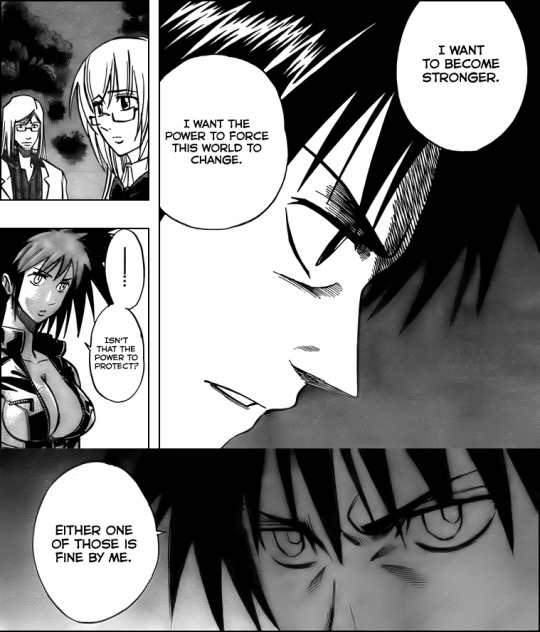
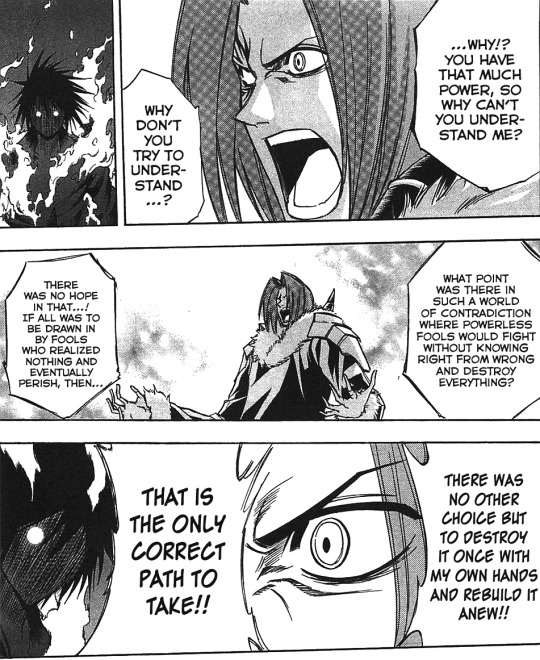
ageha and miroku work so well as protagonist and antagonist because they’re so similar at their cores
they have stark contrasts throughout the series, such as melchsee’s door being pitch-black and devouring everything while sephirot is pure white and known as the ‘tree of life,’ the sun and moon comparisons
but at the same time there are also references made to how similar they are, the adaptability of their powers as noted by yusaka and an actual resemblance as noted by #07

even kabuto’s story in the second novel touches on it

both of them have the mindset that they want to change the world, regardless of what it takes and what they must do in order to achieve it
and i think what makes ageha really work in comparison to miroku is that he doesn’t do a lot of acting based on ‘general idealism,’ he’s not very preachy on ‘right or wrong,’ he just sees what’s happening and disagrees with it so he acts on it and calls out those who oppose him

which makes their confrontation feel so natural when ageha doesn’t try and take any higher moral ground, because he himself is guilty of a lot of the ways miroku thinks and we see that as the series progresses

they both operate off the same core of “i want to make the world change” and the only thing really separating them is how they apply this and to what extent
1 note
·
View note
Text


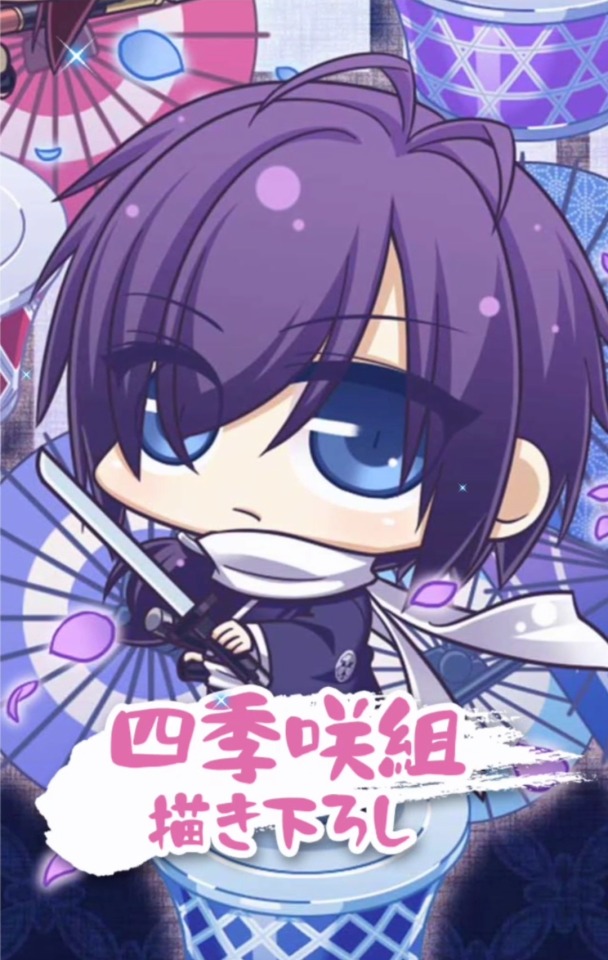

Hakuoki Sephirot Fanset (Saito, Ryouma, Harada) • 31/5/21 💜
#hakuoki#hakuouki#hakuoki Sephirot#Sephirot#Sephirot cards#hakuouki Sephirot#otomate#Sephirot world tree of time#Hakuoki chibi#otome#otome boys#otome illustration#otome cg#sakamoto ryouma#ryouma sakamoto#hakuoki shinsengumi kitan#saito hajime#hajime saito#harada sanosuke#sanosuke harada
85 notes
·
View notes
Text
Hey so I just downloaded Sephirot, and I’m still confused on how it exactly works. If anyone is willing, could you help me out? Just DM me :) I’m a newbie at this game and I just need some help navigating it ;u; ❤️
5 notes
·
View notes
Photo

Live Post? I’ll organize everything here. I still have a lot more to upload. This blog was dead thanks to school. I mainly wanted to store all the lovely videos from the animated card since they don’t return once expired ;(. Maybe I’ll have more time during the holidays :< Please enjoy everything I post. I’ll be live editing what I post since I’m still going over what I wrote in Español.
10 notes
·
View notes
Text
Dear Sephirot players,
Is there a play through explanation anywhere? I’ve been trying to search for one. I finally got the game on my tablet. But I’ve been having issues with locating a how to play. If anyone has any links I would be grateful. <3
0 notes
Note
Funny thing about sephirothmon is that its based on the kabbalic tree of life! Its name comes from the term sefirot/sephirot, which are the 10 attributes in kabbalah
Each of sephirothmon's orbs is a different sephirot, and it has the same tiferet symbol as rosemon's jewel, and tiferet is one of the sephirot in the tree of life!
(well dang! How fun to learn about djfjd
It's always fun seeing what a Digi is inspired by in some ways when they do have proper history to go off of, but that's how Digis b since they are made from data of real world things a lot of the time djcjjdjd
4 notes
·
View notes
Text
We’re at the end of the road, folks.
And god damn, I feel so validated by my Sojiro characterization. Wow. Thanks for basically making me canon for ten more seconds, Atlus. XDDD
So when last we left our intrepid heroes, they were laying at the bottom of the Jail of the Abyss, because Ichinose is an asshole. So we had to fight our way back up, carrying Sophia’s unconscious body. Which wasn’t that bad; the Jail isn’t very big. We left Sophia at the door to keep her safe, and then charged back into the hall of the Ark to hack Ichinose’s exploding crystal box thing.
Ichinose doesn’t understand why we came back.

So, yeah. I guess like... bizarro-world Maruki? Maruki wanted to alleviate suffering by granting everyone’s wishes. EMMA’s going to make it so that people can’t wish for anything.
After a kick-ass hacking battle set to the new version of Rivers in the Desert, Ichinose yells at us about our right to judge. Why should humanity keep this painful world, just because WE’RE strong? Just because we’ve never screwed up or suffered?
Which, clearly she has no idea who the fuck she’s talking to.
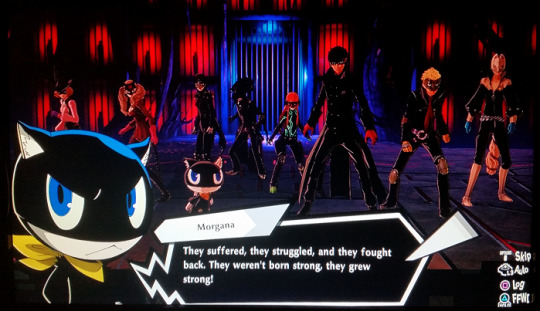
We’ve worked too hard to listen to that kind of bullshit.
Ichinose proclaims that “humans don’t need hearts” and charges up the laser crystal to blast us again, and Sophia steps in to block the attack. She’s still fighting Ichinose’s control even though Ichinose insists that she’s just a faulty prototype.
Apparently Ichinose created Sophia in the first place because she spent a lifetime being called a heartless doll, so she made an AI to help her learn about the heart.
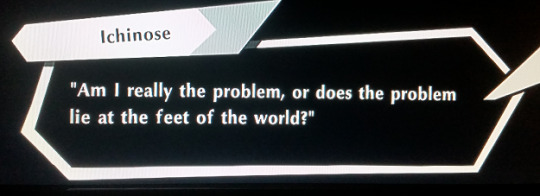
I think you’re the problem, but not for the reasons everyone else is saying.
But she got angry when Sophia started asking questions of her own and basically tossed her aside, until EMMA found her and dropped her into the Shibuya Jail.
And Sophia, unlike her creator, has learned and grown, and is tired of being given orders. She’s ready to make her own choices.
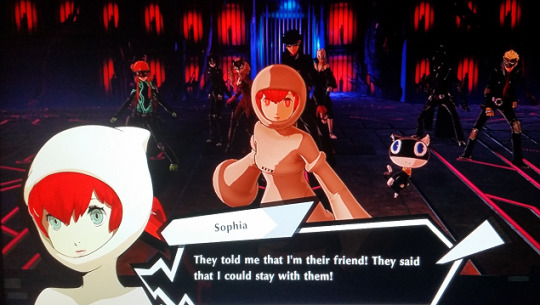
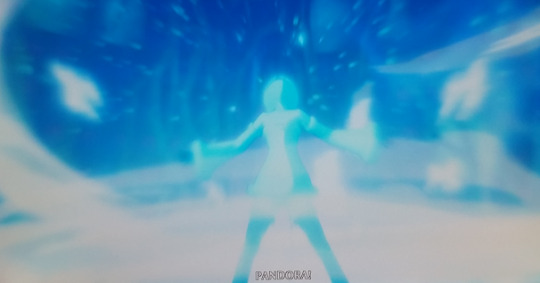
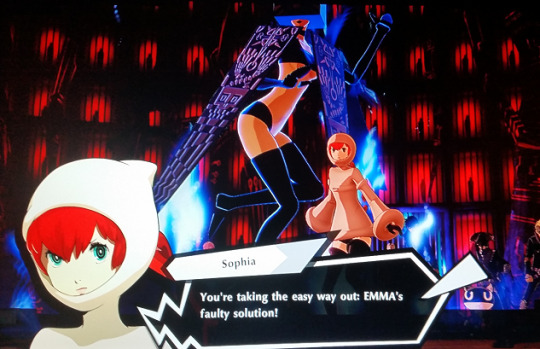
That is certainly a persona.
I gotta admit, they got me. I was wondering why Sophia didn’t have her arcana yet, but for some reason, I also wasn’t expecting her to get a proper persona. I’m now wondering about the implications of someone being able to code an AI capable of developing a soul that can summon a persona. There’s a zero percent chance that Ichinose had any access to plumes of dusk, which are the reason that Aigis and Labrys gained enough consciousness to have personas. So Sophia is legitimately a miracle piece of technology.
Pandora is an interesting choice, but I dunno if I can articulate that beyond a surface-level, “Oh, because she’s Hope, and Hope was still in the box.”
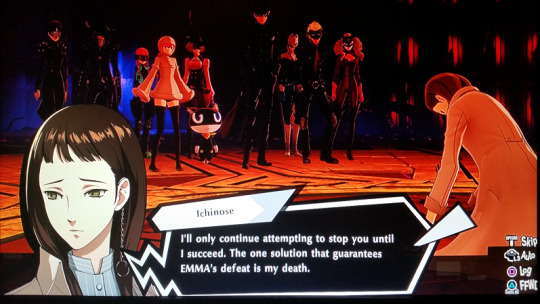
I swear to god, every major villain in this game is trying to be Goro Akechi. For the last goddamn time, we don’t kill people. Get up, Ichinose. We’re leaving.
Ryuji literally grabs her by the arm and drags her out, because she’s trying to stay behind. Which just confirms for me that if Goro hadn’t put up that bulkhead door, we’d have dragged his stupid ass out of the Ship, too. XD
Back to the real world, and Tokyo is blacking out, and the Tower is losing its shit.
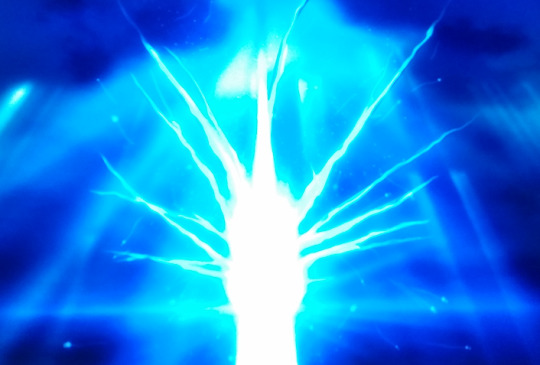
The metaverse is fusing with reality, the Tower is becoming the Tree of Knowledge, and hell yes we are climbing this tower after all!
Morgana points out that this is the same thing that happened last year, and Zenkichi freaks out a little bit.

You’re lucky you moved to Kyoto, sir. You missed quite a bit.
I love these kids, though. They’ve got so much black humor about this whole god thing.
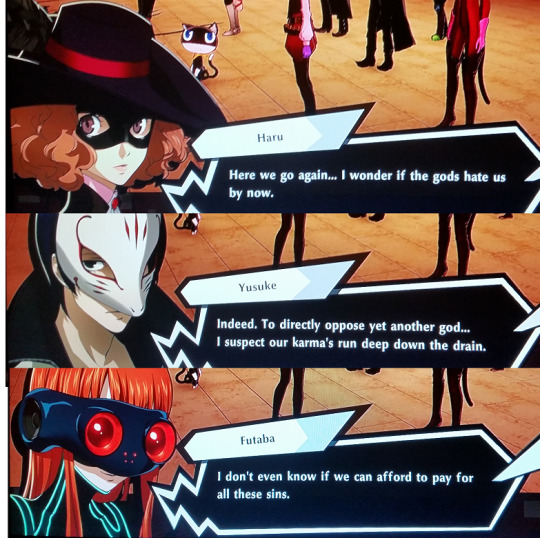
The metaverse encroaching on reality means that everyone has to cram into the bus in their thief gear. Zenkichi, please. Your hat. Sir.
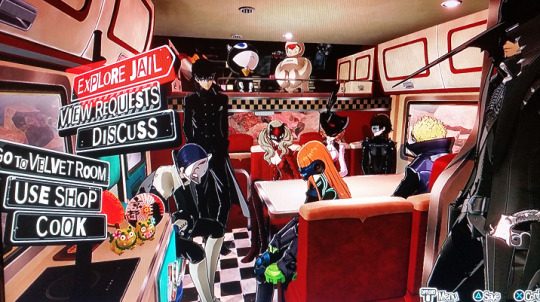
I love climbing this tower. I’ve been here, too! Also they have butter. XD

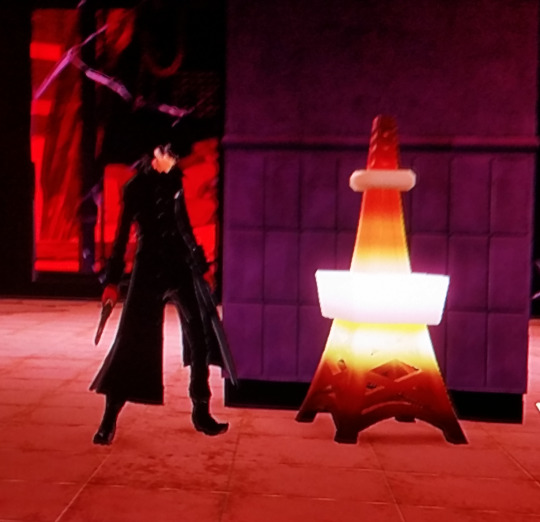

I was expecting the Mementos version of the lower observation deck, and instead I got some weird amalgam between Mementos and Azathoth’s boss chamber.
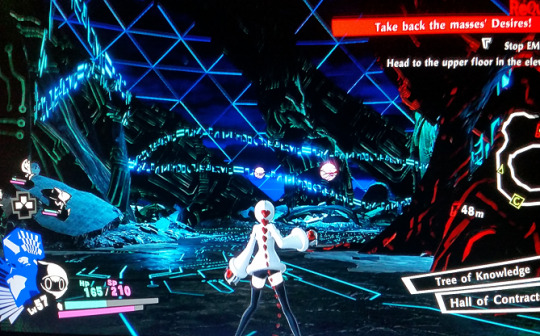
We had to fight Metatron as the guardian of the last elevator, which is another parallel to Yaldabaoth’s archangels. And then it’s up to what I guess used to be the high observation deck to fight the big box.
EMMA insists that all humanity wants is to let it give them all the answers, and it throws them into some sort of alternate fog world full of the voices of the public.
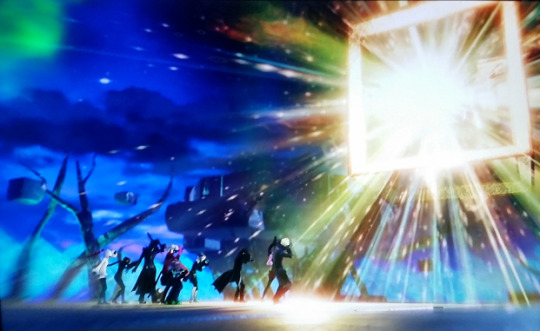

The Thieves are all separated, trapped in the fog. Each of them has to find their way out, and they realize that the fog of the Desires is protecting EMMA. EMMA knows exactly how calling cards work, so they won’t work on her. Instead, the Thieves decide that they need to send the calling card to the public, so that they’ll become aware of their desires again and the desires will crystalize.
...oh come on, Atlus. We’re right in the endgame.

One last hacker battle to break into EMMA’s server room in the tower, and Futaba and Ichinose manage to hack EMMA itself to deliver a calling card to everyone at once.
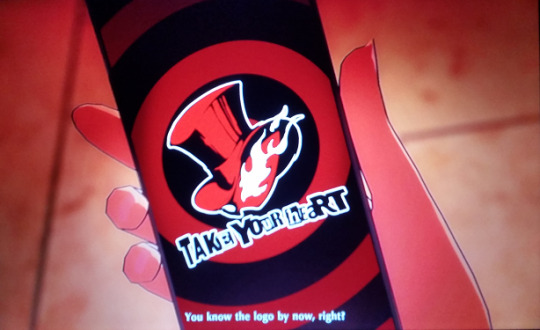
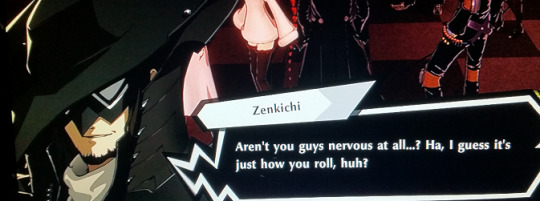
Love you, Zenkichi. We’ve taken out two gods already. We’re good.
Confronting the Ark again reveals a bunch of freaky tentacle arms grabbing the desires, and then the box turns into some sort of massive figure that looks sort of like Yaldabaoth, except less robot and more seraphim. It literally names itself the Demiurge, so I feel like EMMA may be drawing something from the lingering dregs of Yald’s influence? It’s cool.
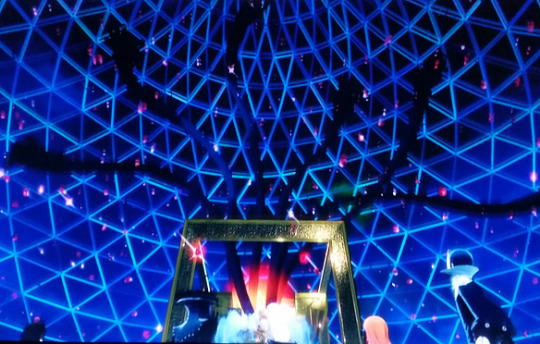
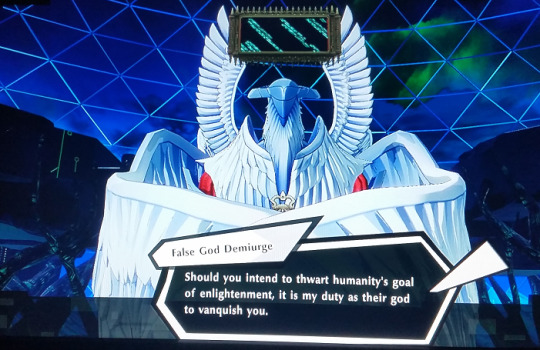
Clearly no one told you what happened to the last false god that thought it knew what was best for humanity. ;) “Hope binds humanity to misery” is bullshit.
After a... not very difficult first phase, the Demiurge reveals its true form, and we split into three teams to take out its support orbs (modeled after the sephirot) and the main body.

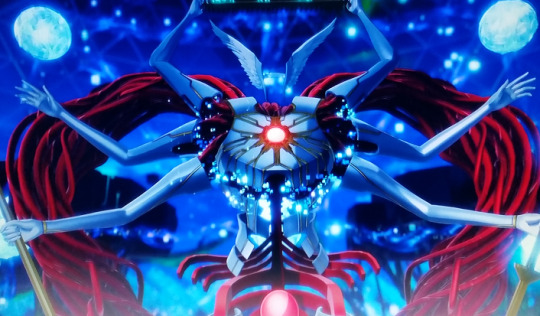
I really liked the setup for the last boss. The teams were the first instance where it was really apparent that the whole team was fighting together. Each of the three battles was happening concurrently, and destroying the orbs has a concrete effect on the main fight. I wish we’d gotten to do things like this more often, especially during the Shadow Thieves fight.
That said, the main body was actually the easiest part of the fight? All the attacks were really telegraphed, and not particularly hard to avoid. Except for the spear jab.
But it finished off with a full-team all-out attack, and that was awesome.
The desires began to return to their owners, and we get to bask in a job well done once again.

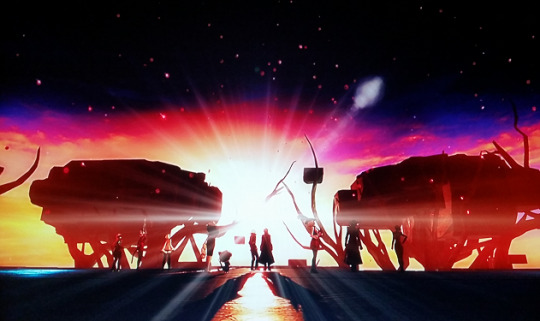
Upon returning to the real world, it’s the next morning. Sophia’s happy that she got to be a hero, Zenkichi’s heading off to properly arrest Owada, and the rest of us need to head home, because we were supposed to be home last night. Zenkichi can’t figure out why we consider him a phantom thief, since he “only joined [us] to use [us]”. Which is silly. The Phantom Thieves are built on the bonds of friendship and stalking! It’s too late, Zenkichi. You and Akane have been adopted.
I’m a little disappointed we didn’t get to tell Akane the truth. That would have been great.
Atlus personally reaches out and pats me on the head, because Sojiro has the absolute perfect reaction to his kids coming home after a nationwide manhunt for them.

I feel so valid making him serve Lavenza coffee and be completely nonplussed about a guy marrying Death. I love him. We’re so lucky to have Sojiro. XDDDD
The next day, the kids have a celebration party for their victory, and learn that Akira is going home the next day. This kid needs to catch a break. He can’t even have a few days to relax with his friends. X’‘‘D
Everyone goes to see off Akira, though we detour to Shibuya to meet Ichinose. A news report shows that Owada was successfully arrested, and apparently Ichinose tried to turn herself in to the police, and they didn’t believe a word of it.

This is just highlighting my issues with Maruki. Even if he doesn’t think he did anything wrong to society as a whole, he never apologizes to them for what he put them through. Especially Akira. Ichinose turns around and helps them stop the final boss, and her last scene is her apologizing to the Thieves and trying to make amends for her actions. Maruki’s last scene is... “If things get bad, you can start over like me! Now we’re even!” We are not.
Sophia leaves to help Ichinose learn about the heart, Akira promises to come back for winter break, the Phantom Thieves go their separate ways once again, and the credits roll.
I’m gonna leave my final impressions in a different post, because this one is long enough already. So... look forward to that?
10 notes
·
View notes
Text
The Mist's Angels
Out of the mist, the Angels come. Death incarnate. They whose blood runs deepest were there upon the final day of the Heresy, when demigods clashed and rivers of genetically enhanced blood flowed, loyalist and traitor alike. They were there when The Mist was struck down. And they will be here long after us; full of bitterness and seething hatred towards the traitors who killed their mother, and shame towards their own failings and curse.
They are the Corporation's most brutal, savage warriors when pitted against the enemies of mankind, lost in a bloodlust and rage that has been with them since the start, yet when off the field of battle they are nothing but secretive, cunning, and superstitious.
It is known they are hiding something, it is certain, even, but what it is they are hiding is unknown to all but those among their ranks.
Once headed by the Sephirah, Geburah, they are now all alone; Left to fight endlessly in the darkness of these millenniums, with no end in sight.
With a highly unstable geneseed and a gradually increasing list of splintered teams, they nevertheless push on.
Their Sephirah, Geburah, was originally a high ranking fixer, highly trusted by Ayin once they all were absorbed into the quickly forming Corporation.
During a widespread rebellion in Branch 5, District R, a branch which highly resisted unification, her position was overwhelmed by highly trained enemy combatants and she and many others were slain. A small group of fixers, however, managed to recover her alongside the body of what would be another future sephirah.
Her brain was somehow kept alive by technologies long-since forgotten, long enough for the transfer process to begin. Though just speculation, it seems as if Ayin, though we dare not speak ill of him, had already prepared the necessary genetically engineered body required for transfer, as if he was expecting her to die sooner rather than later.
At that very moment, she was no longer a fixer; Instead, she was Subject Geburah of the Tree of Life program, a Sephirah, who would later go on to earn various titles, and eventually, reclaim the title she earned as a fixer.
Gebura, like many other sephirah, did not quickly grow accustomed to her new stations as a general, and like the others, shared no memory of her past life. Emotional outbursts were regular during the early days, but became more and more frequent as the years went on.
The outbursts, however, were evolved but largely unchanged as time passed by.
As stated above, even from the beginning, she was known for her unbridled rage and, though previously unstated, also known for psychic outbursts that would occasionally occur.
It eventually got to the point where, despite her and her legion's excellent track record, she and them were feared. Even other legions were apprehensive to fight alongside them, despite their unquestionable loyalty.
They as a legion were secretive and odd from the beginning. Many of their operations ended up classified, records of Employees recruited into them completely expunged, and an unspecified, vaguely defined meeting between Gebura and one of the other psychic Sephirah.
But, the previously mentioned things that were and still are part of them as a Legion only were exacerbated and pushed to their logical conclusions during the most unspeakable, horrifying event since the first battles of the Unification.
The Heresy.
Gebura took the Heresy possibly the hardest, second to Netzach.
On the day the news of the betrayal from her brothers and sisters reached her, a Shockwave of psychic energy flooded both real space and the Stream, causing weaker Psychics everywhere to collapse and begin clawing their eyes out and deafening themselves.
And on her ship, the first records of what is only known as the Bloodcursed of the Mist's Angels emerged. At the time, it was a one off incident, but it soon started happening to her own Employees everywhere she went, when her rage became too overwhelming for even her. No details of what the Bloodcurse entails have ever been known.
- - -
Record Date: [OMITTED]
Ship Log: #3283-P
Author: [OMITTED]
Incident Description: Upon the news of the incident in the Outskirts of the solar system reaching us, our gene mother let out a deafening howl of rage so pure and so intense that all glass within a 130 meter radius shattered instantly.
Her honor guard were deafened by it, and some had visions race through their minds of an unrecognizable battlefield and bleeding demigods.
Some of them would not calm, and had to be executed.
It was a singular incident.
- - -
From there, her anger not subsiding, she quickly met up with her loyalist brothers and sisters, and entered into a meeting that is, to this day, classified.
What was said is largely unknown and no eyewitness accounts ever escaped the meeting room, besides one, from an unknown persons who never gave their name.
And what was disclosed from that account is that Hod, still masquerading as a loyalist, only appeared over coms, and with a convenient excuse; She was stuck fighting a several month long battle and wouldn't be there in any good amount time, but would eventually make it.
Eventually, begrudgingly accepting what Hod had said, they decided on a plan. They would rapidly approach and decimate the district and branch their heretical brothers and sisters were held up in.
Not one planet would survive.
And they did just that, until, at last, they got to the final planet that they knew for a fact the heretics were held up in.
Upon arrival to the planet, the heretical Sephirot, at the time, were officially not many. But, it would soon be found that even those by the loyalist's sides couldn't be trusted.
During the descent on the planet, panicked com signals reached several members of the Mist's Angels, all originating from the Flagship of The Cherishers, Hod's Legion, the ship known as the Light Carrier.
Panicked screams of agony rang out and gunfire echoed as a single message got through.
A scream of the short exclamation:
"DON'T LAND!"
Something was wrong.
On the Light Carrier, unbeknownst to the other Legions at that point, there was a massacre occurring. Every Employee from another Legion that was on it was being systematically and horrifically maimed and murdered by the traitorous Cherishers in a display of brutality and treachery unmatched, until the events that would follow on the planet down below.
The planet spoken of previously, officially, had no proper name- just a number and designation- but the inhabitants of it called it Babel. Before being taken over, it was a haven of knowledge and advancement, who's main exports were geniuses, books, and technology.
By the point the Mist's Angels and other legions arrived, what was left of the civilian populace was bones and slaves.
When word of the transmission got to Gebura, it was far too late. Troops had already landed and secured their positions.
Trusted members of the Mist's Angels were found dead in their chambers, replaced by members of the Golden Legion, and the ships sabatoged in kind.
Soon, coms went silent aboard the Flagship of the Mist's Angels. Not due to bloodshed, but due to the fact that all communications were disabled. The controls were disabled.
And it wouldn't be up and running for many hours.
No warning arrived to others, but the Mist's Angels knew what was coming. And they, and their Sephirah sat helplessly as the troops they did send, and those of their brethren, fought on the planet which would become their grave.
After two hours, the forces of the Mist's Angels on the ground realized while engaging enemy forces that the coms from their Flagship had gone silent- and nobody could figure out why. After five hours, speculation ran wild, but no real consensus was reached.
Thirteen hours into the fighting, when the heretics seemed to be on their last legs, tactical maps showed that, as they advanced towards the enemy, massive groups from three legions were approaching from behind- both behind them, and behind the enemy.
It was seen as a blessing by those among the Mist's Angels; Reinforcements arriving to help finish the job, when several of their allies- besides the two groups from other legions accompanying them- were fighting on another front or engaged in space combat.
They were horribly wrong.
It didn't take long for the renegade legions of the Golden Legion, the Cherishers, and the Crown's Heralds to reveal their treachery.
All accompanied by their Sephirot save for the last, they immediately launched their attack. Confusion was rife, death was constant, and on an unrecognizable battlefield, demigods bled.
The forces of the Mist's Angels that were on the ground were massacred brutally. A few made it off-world via transports, but they were outliers.
And the rest, as they say, is history; A bitter, sad history, but history nonetheless.
Years later, during the final battle of the Heresy, long after this massacre, Gebura succumbed to her wounds and died at the hands of one she had once thought as her sister.
- - -
Several thousand years after the Betrayal of the Three, and the Heresy as a whole, the Mist's Angels are splintered and fractured.
Mental instability, even more dark secrets, unstable Geneseed, and the ostracization of Teams due to even minor mutations all cloud their present and their future with the oncoming darkness; The darkness approaching Both the Corporation and the Mists Angels.
They fight without cause, without their Sephirah, and without purpose in a galaxy that fears them all. But they fight still.
May the dawn shine upon us all.
- - -
Gebura woke up somewhere dark and distant from the battle she was just in. Her last memories were of something going straight through her chest, and more blood than she had ever seen come out of someone before.
As she stood up, she felt the cold floor beneath her feet. Hard and glass-like.
She knew she wasn't wearing her armor anymore, nor was she wielding her weapons; And she couldn't see out of her right eye, but she could feel her blood dripping down her face.
Soon after standing up, her anger and rage from the battle before subsided quickly, and all that was left was confusion as, in the distance a light appeared.
The light burned brightly and, as she walked towards it, it burnt brighter.
Every step seemed to cause the light to grow brighter, and every step felt far lighter on the ground than it should have been.
As she got to the light, she noticed it was a burning feather, held in suspension by some sort of chain.
She tugged on the chain and...
Nothing happened, for awhile, at least. She felt like something should have. Like something was off.
And then it happened.
Thousands of massive, bright yellow eyes illuminated the darkness around her, like spotlights littering a city skyline.
Then, they closed.
#Lobotomyhammer#The Mist's Angels#Another codex after a really long time. Is anybody still interested in these?
2 notes
·
View notes
Text
IX – The Hermit Tarot
“self discovery through introversion”
Symbol: Retreat, self-communion, silence
Zodiac: Virgo
Path of Yod: Chesed -– Tiphareth
Date: Winter solstice
Ritual: Asceticism and meditation
Archetype: Kronos as guardian of time, Hermes, Thoth
I
This archetype represents the wise but seclusive hermit. The old man embodies retreat, quietness and introversion. This card symbolizes the search for truth within ourselves and retreat from the world and all of her distractions.
The lantern guides his way through the darkness of the mysteries not yet discovered. Within the lantern shines a light symbolized by the tree of the Sephirot. This means he has a map or a concept according to which he can collate his experiences.
The kabbalah is a symbol which could be replaced by the periodic table, an alphabet or a source code. This special assignment or order keeps the hermit from getting mad in his studies. Unfortunately, if an outsider or stranger who doesn’t know his scheme watches the hermit, he must appear like a lunatic or maniac.
So usually he is forced to be quiet, because otherwise the world might try to harm him just because he seems different. This is a dilemma, because often a hermit would have much to say or contribute to his society, but excluding himself makes him unable to translate his insights or knowledge into common language.
instagram
7 notes
·
View notes
Note
Is there a possible connection between Heaven's Edge and Heaven (Justice's stage) by any chance? It seems too much of coincidence that Jack-O and Justice's stages are named with the word Heaven, so I'm sure they are likely referencing the Scales of Juno to some extent, but I'm wondering if they might be taking place in the same area or something.
While there's certainly a motif going on, it's difficult to pin down exactly what Ishiwatari is going for.
In the case of Justice:
---Has an attack called Michael Sword/Michael Blade which suggests angelic origins, as in the "Sword of Michael". Angels are said to be guardians who keep watch over hallowed places, not simply Heaven as a location, but other places mankind is forbidden to enter, such as the Garden of Eden, which God supposedly cast humankind out of, for tasting forbidden fruit.
---Justice' name bears a connection to Juno... as in the "Scales of Justice", the embodiment of balance and Law and Order. Justice herself derived her name from a desire to punish Mankind for enslaving her.
---Heaven's "appearance" is a Gateway, a stairway of sorts, but that stairway is eventually destroyed as if to suggest Mankind's violence has broken their connection with God.
In the case of Dizzy:
---While she is considered a backup of Justice, she bears an even MORE "angelic appearance" than even Justice originally did. Dizzy's form even suggests a mix of both angelic and demonic origins: meaning that Heaven and Hell are somehow related to divine origins.
---Dizzy's first appearance in The Grove stage also implied Heaven in terms of being its own natural "paradise", a peaceful place beyond the conflicts and struggles of humans. The Grove also suggests the "Garden of Eden" as well...
---Prior to Heaven's (stage) destruction, the Roman-like pillars and stone masonwork are also both angelic and demonic in appearance... as if to say that Gears aren't beings of this world to begin with.
In the case of Valentine:
---We first find out about a place called the Backyard in GG2 Overture, which is said to be where Valentine was born... a world of raw information that somehow compelled life in to being... that life being "Valentine", as if to suggest that creation is nothing but a trifle in such a realm.
---Valentine, despite her initial demonic appearance, transforms into a being with wings, but those wings are crucified hands... symbolic of Christ's crucifixion... the death of the son of God.
---The place in which Valentine is fought is as if a sea of blood... sometimes also called the "lake of fire", or Hell itself in some interpretations... where Mankind is judged.
---Valentine is described as an "illegitimate child", which suggests children born between angels and humans that were abandoned by God: Nephilim.
---The Backyard itself is deeply connected with the concept and origin of Life itself, and the opposite spectrum: Death, or the Underworld, as described by Izuna. Spirits and inhuman entities exist there, beyond the pale of human reckoning, just as angels and demons have existed in such places... "Heaven" and "Hell" beyond the concept of Life: the After-Life.
In the case of Jack-O'Valentine:
---The story of "Stingy Jack" suggests a lost soul, an unborn half-soul, a wandering being who still has her halo.
---Instead of a normal Servant (like Lucifero), Jack-O' has a ball and chain around her ankle, as if to suggest she escaped the confines of Hell or Purgatory: a runaway.
---Jack-O's win pose in which she swings upside-down is reminiscent of the Tarot "Hanged Man". Symbolically a Hanged Man is bound for death... their fate is sealed and they are unable to do anything. In Tarot, this means things are put on hold, out of your hands, or that something will happen for you (for good or bad). A condemned Soul.
---Heaven's Edge is described as a "tomb dedicated to possibility"... but such a concept is contradictory. How can a "tomb" represent what is "possible?" Perhaps a barrier, or sealed existence.
---The endless horizon of Heaven's Edge is virtually the polar opposite of the "red sea of blood" we saw in the Backyard... as if to say that there is "harmony" on one side of the coin, and "chaos" boiling on the other side.
---In that sense, Heaven's Edge might be more accurately described as "the edge of hell", or the gateway to the Backyard itself... though Hell is described as a pit, it is also sometimes described as Qliploth... the roots of a demonic tree.
---Heaven's Edge (the stage) also periodically displays imagery from the Sephirot, the "angelic spheres" that are sometimes said to be what connects mankind to godhood...
Gathering all that we know so far... Gears embody mankind's concept of a God (The God bites own lip in chagrin/Kill DOG as a Sacrifice to DOG (Dog is GOD backwards, rephrased it could mean Kill GOD as a Sacrifice to another GOD).
Sol is the "Guilty Gear" and has been killing Gears (gods/dogs) for some time now... even Valentine was killed "the illegitimate daughter of a God". Humans seek the forbidden power of God... even trespass in to that domain: a realm of untapped power and creation, as well as destruction and chaos.
The Backyard is both a realm of Life and Death (Heaven and Hell), and most things, even Gears, were born from such a place... even twisted humans.
Guilty Gear Strive's trailer suggests Mankind will rob themselves of free will, perhaps as a necessary step towards a peaceful world... but such a concept lobotomizes the definition of being "Human".
Freedom? Or Order? Which will mankind choose?
A realm of freedom is sometimes Hell, sometimes Heaven, depending on how you look at it.
So is a realm of Order and Law.
But that's all up to those in power (Men posing as Gods) to decide.
3 notes
·
View notes
Text
I’ve been playing the end of royal again for kicks and thinking more about my p5 verse.
spoilers below:
First, I’ve just been enjoying the parallels between P3 The Answer and P5 The Royal. P5 especially borrowed much from its predecessor.
At 3′s core its themeing mainly stems from Greco-Roman myths with a sprinkle of Jewish mysticism, while P5 goes heavy on the Judeo-Christian lore and Gnosticism.
The floors of Tartarus are all named after different Hebrew words that I’m sure are from somewhere but I’m not sure where whereas the doors in the abyss of time are all named for the different circles of hell in Dante’s Inferno.
Mementos is also named after Hebrew words (though I believe they’re gibberish?) , and references the Qliphoth (the opposite of the Sephirot, or Tree of Life.) In P5R, this culminates with the very last level being Da’at, or ‘wisdom’. The Sephirot also references the Fool’s Journey, and is something that Dr. Edogawa gives a lecture on during summer school in p3.
Metis describes The Abyss of Time as stretching out below the Iwatodai Dormitory ‘like tree roots’, bringing to mind mementos and its winding, root-like depiction; and when we dig into that deeper, SEES finds themselves unable to leave their dorm due to their collective, unconscious wish not to move on with their lives. That desire was strong enough to warp reality around them, and link their dormitory to the Abyss of Time. If Mementos is society’s collective unconscious, then the Abyss of Time was SEES’s. Or at the least, they created some cognitive distortion.
As a side note, Metis and Morgana both appear mysteriously to help the characters through their new circumstances and have retrograde amnesia as to their origins. They also both disappear :)
Another part I found interesting is when SEES is ready to fight Erebus and they’re commenting on the state of the world: how society’s ennui and passive s*icidal ideation is what called down Nyx, and how they, at some point in their lives, have all done the same. Fuuka comments, ‘For [Erebus] to truly disappear, everyone’s feelings must change’. Their general consensus is that they can’t change society, but they can change their own mindsets to help make the world better. They promise to hold onto their evokers ‘until the day when everyone can change’.
And then P5 rolls around and screams ‘life will change’. The Phantom Thieves act not like the persona-users before them, but as the shadows, ripping off their own masks to ‘reveal their true selves’ and changing cognitions. A mental shutdown is just apathy syndrome rebranded.
But what I really wanted to talk about
....was my p5 verse with all of this in mind. If the shadow operatives are working undercover I want to know what they would think of Maruki’s world-- how they would cope with that? I want to write their perfect illusions. I want that difficult choice of being free of pain versus a life worth living. Would Maruki be especially merciful knowing how much they’ve been through. It has so much potential I’d love to play around with it in some way. Not to mention if a Maruki would be involved it would be fun to write with two adults for once instead of SEES hanging out with teens lmfao. how do you do fellow kids.
anyway. I love takuto maruki and sumire is literally akihiko :/
if you read all of this send me an eggplant and I'll write you a ten page starter.

#;meta#things i never knew i wanted#p5 royal was 10000000x more fun when i was thinking of all the potential P3 crossovers and rp scenarios that could come with it LOL
14 notes
·
View notes
Text
Alright I haven't drawn them yet, and I probably won't until all the Sephirot have stands, but until then here's a list of the sephiahs that do have stands and a brief description if I came up with an appearance
Angela
Stand name: Acid Bleeding
Stand type: Long range colony stand
Stand stats:
Power: D
Speed: A
Range: A
Durability: C
Precision: A
Potential: A
Stand ability: Similar to Lovers, Acid Bleeding is a very small stand that affects the targets brain. Unlike Lovers, it can affect multiple people at once, and it effects how people perceive things. While affected, the target will see the world how Angela wants to see it, whether it's removing certain objects from view or simplifying the world so it's easier on the human mind to see it. It's basically the cognition filter from the game
Stand appearance: alright here's where I get a bit less confident. I know I want her stand to look fairly robotic, so I was thinking maybe like little cameras attached to screens that display what Angela wants them to see??? I'm not that sure quite yet
Random facts I feel like mentioning: The stand is named after the song that plays for the 2-3 lines of dialog where the filters down. Also it has such high potential because I'm planning on completely changing what the stand does for Library of Ruina Angela because she's a very different character in Ruina
Yesod
Stand name: Violation of Black Colors
Stand type: Short ranged humanoid
Stand stats:
Power: E
Speed: C
Range: B
Durability: B
Precision: E
Potential: E
Stand ability: The stand, when hitting something or when it's hit, gives off a powder that, when it makes contact with skin, causes an extremely painful rash to start spreading on the targets skin. The powder can stay in the air for about six minutes before it settles on the ground, but it really depends on how windy it is. It also can mess up the lungs if inhaled. Basically it's just a general bad time.
Stand appearance: The stand, just like it's user, shows little to no skin. It's bandaged from head to toe in black and purple bandages, and wears a long, buttoned coat that goes down to it's mid calf
Random facts I feel like mentioning: the stand is named after some of the music that plays during his meltdown. Yes I am naming most of the stands this way
Netzach
Stand name: The 6th Light
Stand type: Short ranged humanoid
Stand stats:
Power: D
Speed: B
Range: D
Durability:A
Precision: B
Potential: E
Stand ability: I'm not necessarily sure for Netzach to be honest. I know I want it to have something to do with healing, maybe like a passive heal over time unless it's directly touching you?
Stand appearance: The 6th Light look very similar to Netzachs meltdown appearance, kinda lumpy with green streaks and a large, tree like structure coming out of it's back. It's got one eye and no mouth or anything like that.
Random facts I feel like mentioning: I was going to name it Blue Dots after part of his meltdown music but like he's green and so is his stand so why would it be named Blue
Gebura
Stand name: Distorted Night (formerly, the Red Mist)
Stand type: One of those wearable stands, kinda like if White Album had weapons too
Stand stats:
Power: A
Speed: B
Range: C
Durability: A
Precision: D
Potential: E
Stand ability: A suit of armor that can physically manifest damage to it into weapons that are relevant to the damage received. Like of Star Platinum punched it it would get brass knuckles, things like that. The more damage received, the stinger the weapon. It can't manifest all the damage dealt to it, only around 80%.
Stand appearance: It's just the Red Mist, not gonna lie
Random facts I feel like mentioning: Distorted Night used to have a completely different ability. It used to be a stand more geared towards protection rather than attacking, but it changed as Gebura did as she spent more time in Lobotomy.
Sorry this took so long 😭😭😭 and it's not even all of them. I might change these when I go to draw them and I don't know if you have any ideas of your own but it's a start!
@ioestar
#Lobotomy Corp au#ioestar#long post#sorry for tagging you but since you replied i couldnt reblog it 😭😭
9 notes
·
View notes
Text
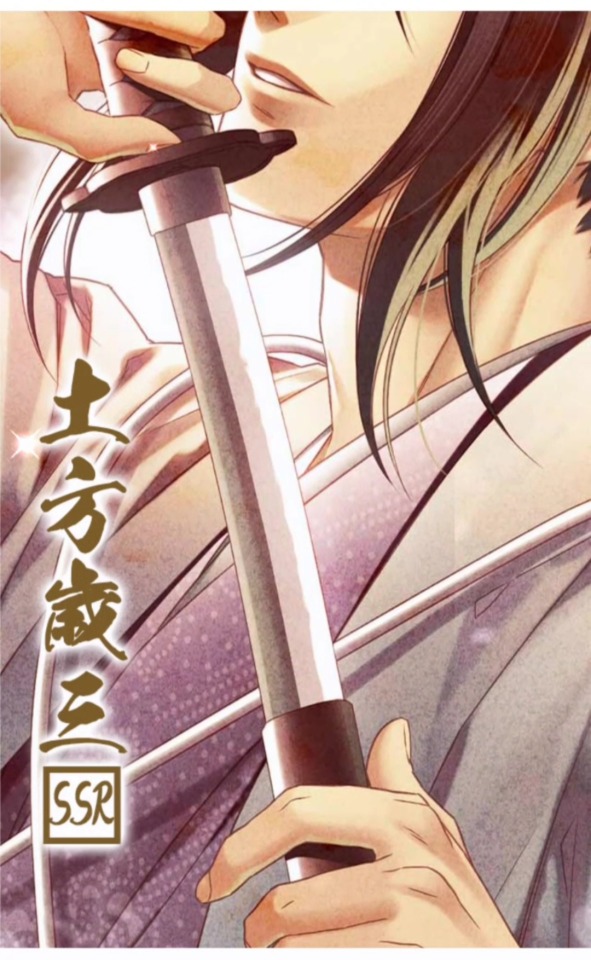


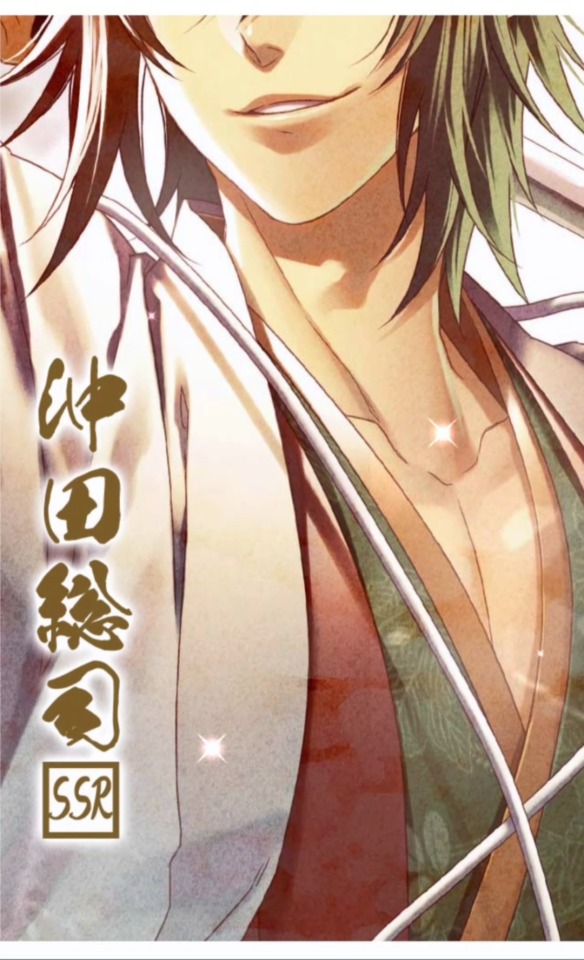

𝐒𝐨𝐮𝐣𝐢 𝐎𝐤𝐢𝐭𝐚 & 𝐇𝐢𝐣𝐢𝐤𝐚𝐭𝐚 𝐓𝐨𝐬𝐡𝐢𝐳𝐨 Sephirot Cards (27/3/21)
#hakuoki#hakuouki#souji okita#hijikata toshizo#sephirot world tree of time#sephirot cards#otomate#otome game#hakuoki sephirot#okita Souji#toshizo hijikata
112 notes
·
View notes